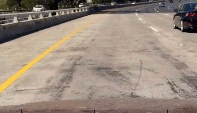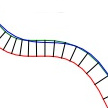Lane Lines Detection Project

This Project is based on the fourth task of the Udacity Self-Driving Car Nanodegree program. The main goal of the project is to write a software pipeline to identify the lane boundaries in a video from a front-facing camera on a car.
It was implemented in Python with OpenCV library. The project repo.
The key idea of the realization is the use of virtual sensors with adaptive position and threshold which analyze the region of interest row by row. It also uses information from previous frames and different techniques of results filtering for smoothing. The code also estimates the radius of the road curvature and the position of the vehicle with respect to the lane centre.
Contents:
Final project videos:
The full project code is available on my Github
Project posts

Adaptive Virtual Sensors for Lane detection
Computer vision approach for road marking detection with adaptive thresholds and positions of virtual sensors.

Bird's Eye View Transformation
Convert a normal image to a Bird's Eye view projection with OpenCV.

Camera calibration with OpenCV
A simple way to calibrate an optical system with a chessboard pattern by means of the OpenCV to reduce distortion.

Approximate equidistant curve for polynomials
An approximate approach to find an equidistant curve for a given polynomial.